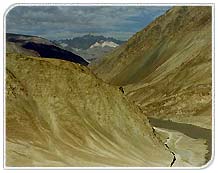Ladakh Travel Guide
---------------------------------------------------------------------------------------------------------------------------------------------------------------------------------------------------------------------------------
Ladakh Home » About Ladakh Travel Guide » Religion & Culture » Historical Background » Ancient Routes » Modern Routes
Central Ladakh » Fairs & Festivals » Oracles & Astrologers » Arts & Crafts » Cultural Tourism » Archery & Polo » Adventure in Ladakh
The New Areas » Tourist Information » Air Line Ticketing » Car Coach Rentals In Ladakh
Travel Agents & Tour Operators in Ladakh » Hotels & Resorts in Ladakh » Map »Travellers Tools
---------------------------------------------------------------------------------------------------------------------------------------------------------------------------------------------------------------------------------
Ladakh Home » About Ladakh Travel Guide » Religion & Culture » Historical Background » Ancient Routes » Modern Routes
Central Ladakh » Fairs & Festivals » Oracles & Astrologers » Arts & Crafts » Cultural Tourism » Archery & Polo » Adventure in Ladakh
The New Areas » Tourist Information » Air Line Ticketing » Car Coach Rentals In Ladakh
Travel Agents & Tour Operators in Ladakh » Hotels & Resorts in Ladakh » Map »Travellers Tools
---------------------------------------------------------------------------------------------------------------------------------------------------------------------------------------------------------------------------------
The New Areas
Drok-pa Circuit
 CKhalatse-
Domkhar - skurbuchan Achinathang - Hanudo- Diama - Dah and return.
CKhalatse-
Domkhar - skurbuchan Achinathang - Hanudo- Diama - Dah and return. Down the Indus, between Khalatse and the Shayok -Indus confluence, live a people, known as Drok-pa, Buddhists in name, but racially and culturally distinct from the rest of the Ladakhis. Two of the five villages inhabited by them may now be visited, Dah and Biama. The route follows the Indus down fromKhalatse, past the villages of Domkhar, Skurbuchan and Achinathang, along a fairly good road.
In the gorge of the Indus the sun's heat, reflected off bare rocks and cliffs, is frequently intense. The same heat makes it possible to take two crops every yera from the fields. Fruit is also grown- apricots, apples, walnuts and even grapes. Skurbuchan, Domkhar and Achinathang are attractive villages, with an air of modest prosperity about them.
But the special interest of this region is less the landscape then its Drok-pa inhabitants. A minuscule community of perhaps no more than a couple of thousand, their features are pure Indo-Aryan, and they appear to have preserved their racial purity down the centuries. Their culture and religious practices are more akin to the ancient pre-Buddhist animist religion known as Bon-chos than to Buddhism as practised in the rest of Ladakh.
One curious feature is their abhorrence of the cow, or any of its products. They have preserved their ancient traditions and way of life partly through the celebration of the triennial Bono-na festival, a celebration of the harves, and partly through their songs and hymns. One of these is a description of an ibex-hunt for the ibex is specially sacred to them. Another recalls their migrationfrom Gilgit - an event which must have occurred well before Gilgit came under the influence of Islam. Their language is said to be akin to that spoken in Gilgit, and by immigrants from Gilgit settled in Dras. Such a small and racially and culturally homogeneous community is bound to have much to offer scholars in the fields of ethnology and social anthropology.
Ladakh Home »
About Ladakh Travel
Guide » Religion
& Culture » Historical
Background » Ancient
Routes » Modern
Routes
Central Ladakh » Fairs & Festivals » Oracles & Astrologers » Arts & Crafts » Cultural Tourism » Archery & Polo » Adventure in Ladakh
The New Areas » Tourist Information » Air Line Ticketing » Car Coach Rentals In Ladakh
Travel Agents & Tour Operators in Ladakh » Hotels & Resorts in Ladakh » Map »Travellers Tools
Central Ladakh » Fairs & Festivals » Oracles & Astrologers » Arts & Crafts » Cultural Tourism » Archery & Polo » Adventure in Ladakh
The New Areas » Tourist Information » Air Line Ticketing » Car Coach Rentals In Ladakh
Travel Agents & Tour Operators in Ladakh » Hotels & Resorts in Ladakh » Map »Travellers Tools